Sourdough Cinnamon Raisin English Muffins
My favorite sourdough English muffin recipe gets a cinnamon-raisin makeover and it’s even easier than the original.
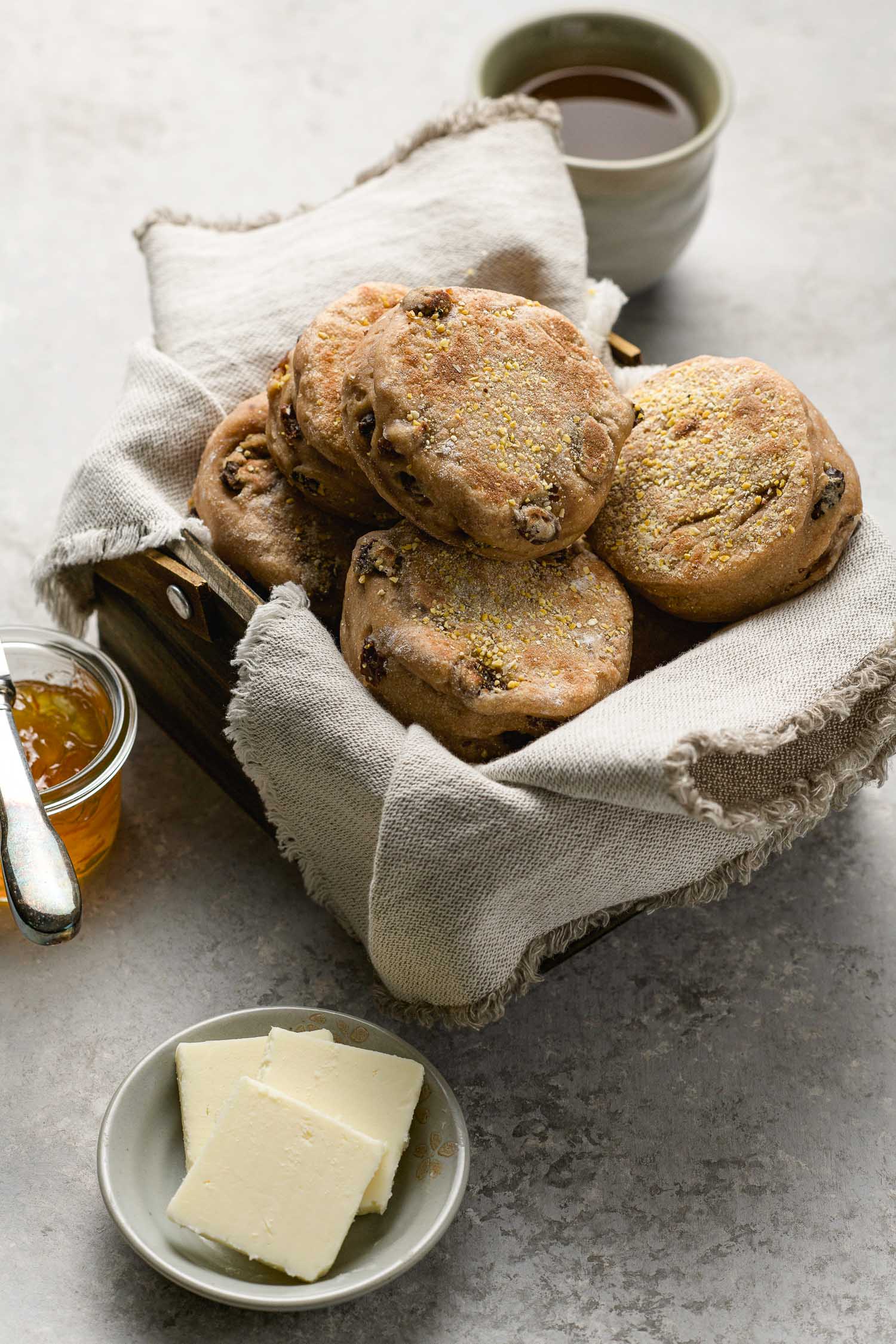
The world has changed in what feels like just a matter of days and being glued to the news for the past couple of days hasn’t helped this worrier one bit. Reason and faith say that we will get through this but the fear-mongering doesn’t help. So I will breathe, focus on positive thoughts and talk about, what else, food.
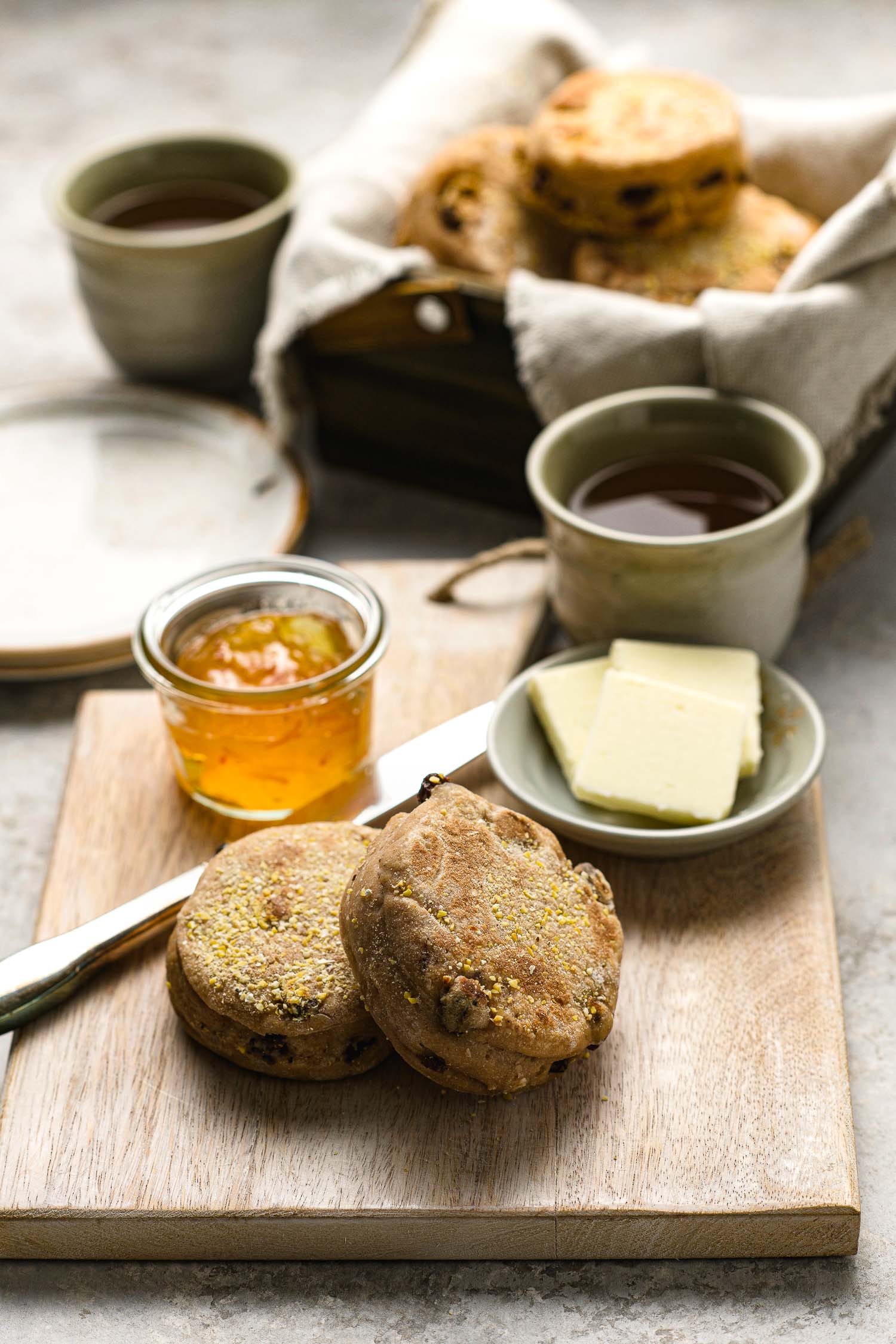
After a long break it feels like I’ve hit my stride again with sourdough baking, something I’m very grateful for with the time we’re spending at home these days. Encouraged by the success of my Sourdough Cinnamon Raisin Swirl bread it was inevitable that English muffins would be my next target.
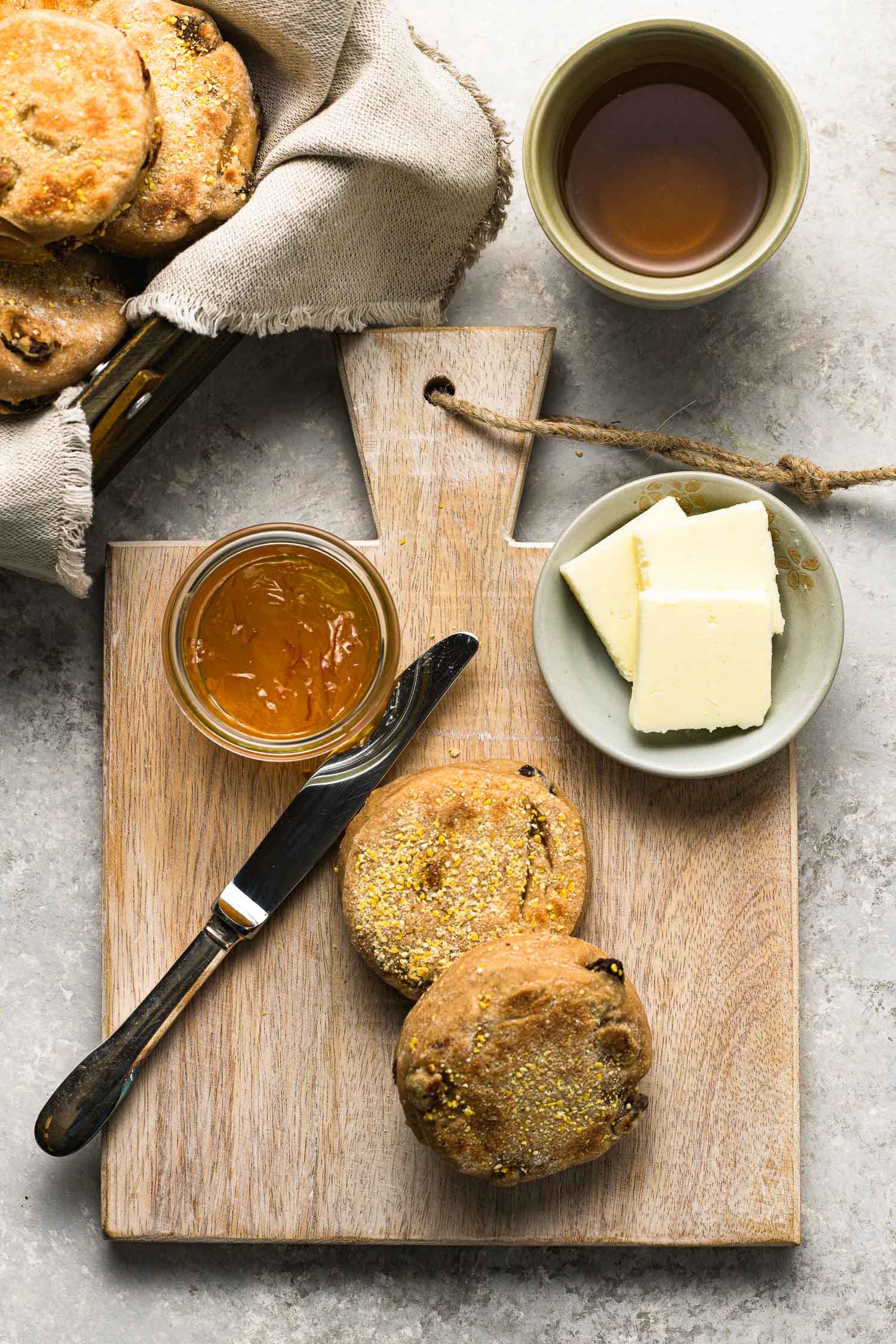
What’s Different About This Recipe?
(My first recipe from 2015: Sourdough Spelt English Muffins)
(My Second recipe from 2019: Sourdough Rye English Muffins)
Sourdough English muffins are surprisingly easy to make. My readers have had success with my two other recipes but always wont to test the limits of sourdough I’ve tried to simplify the process even more here.
Rather than combining the ingredients in stages I added everything all at once with great results. I also eliminated baking soda as an additional leavening agent which turned out not to be necessary at all. Lastly, I played around with bulk fermentation. Regarding the latter, this recipe still requires an overnight wait but if you were to start the recipe early enough in the day (provided that the temperature is warm enough) it can be a same day bake. What this proves yet again is that sourdough is quite flexible.
Some Notes about this Particular Recipe
Sourdough Starter: This recipe is flexible. I usually use 1/2 cup starter for my other English muffins but 2/3 cup worked fine, too.
Cinnamon Flavor: I tend to be cautious about using too much cinnamon since my husband is not the biggest fan. I use Penzey’s cinnamon which tends to be bolder than other brands and the one tablespoon I use in this recipe lends subtle cinnamon flavor so there’s room to add more.
Sweetness: I used one tablespoon maple syrup for this recipe and the muffins weren’t very sweet so I recommend bumping up if you prefer a sweeter English muffin.
Fermentation Time: For this recipe, the dough bulk fermented for five hours in a 75ºF room followed by overnight refrigeration. The other option is to mix all the ingredients in the evening for overnight bulk fermentation at room temperature (my kitchen is about 67ºF during the night). The latter option requires no refrigeration. Both methods would still involve one hour of final proof after the English muffins have been shaped.
Overall Sourdough Taste: I’m finding that fermentation temperature has as much influence on sourdough flavor as time. These English muffins, because they fermented for five hours at 75ºF had a more noticeable tang than my other two recipes. I happen to enjoy a mild sour in our sourdough so keep this in mind when deciding how much sugar to add in your own bake if you prefer much sweeter results.
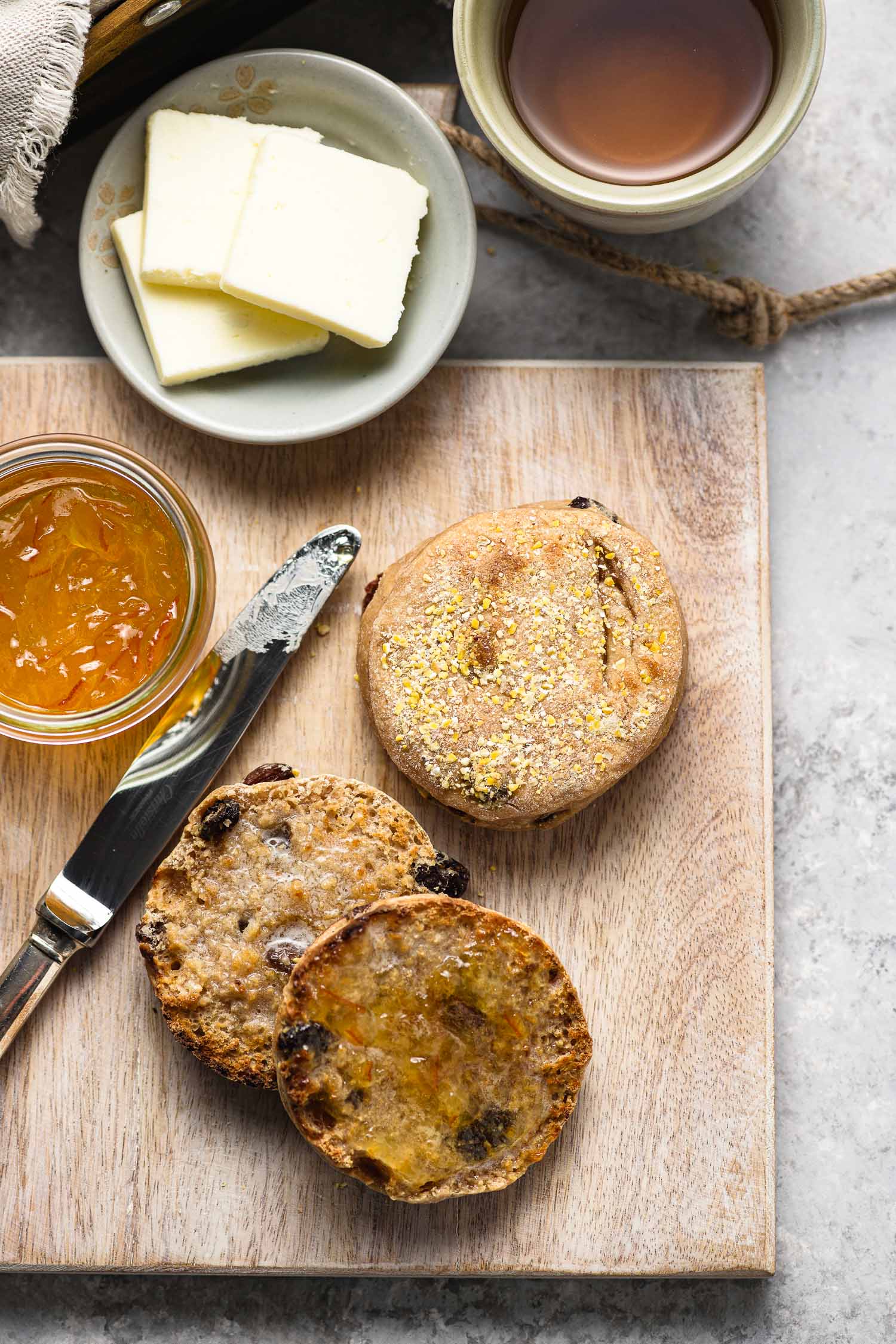
Final Thoughts
Don’t be afraid to experiment. Use my methods and timing as a guide and make adjustments according to your preferences. I’ve never had a bake that turned out badly enough that we couldn’t eat it so be confident and have fun.
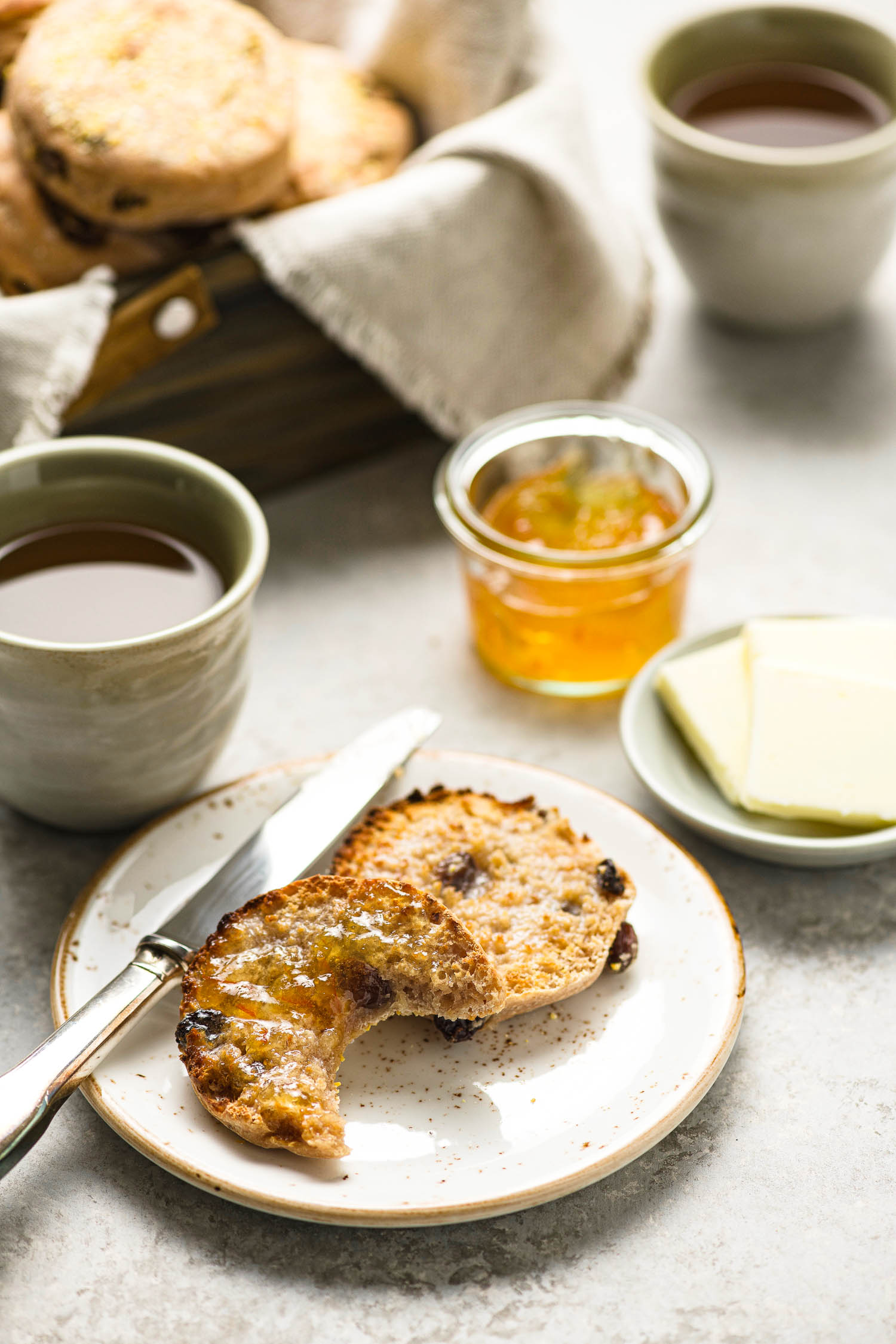
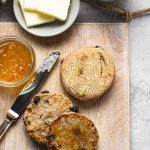
Sourdough Cinnamon-Raisin English Muffins
My favorite sourdough English muffin recipe gets a cinnamon-raisin makeover and it's even easier than the original.
Ingredients
- 1/2 cup raisins (soaked in warm water for 30 minutes) (75 grams)
- 1/2 – 2/3 cup sourdough starter (discard or freshly fed)(See Note) (126-165 grams)
- 1 cup milk, luke warm (any milk should work) (240 grams)
- 2 cups all-purpose or bread flour (254 grams)
- 1-3 tablespoons honey or maple syrup (See Note)
- 1/2 teaspoon kosher salt (3 grams)
- 1 tablespoon ground cinnamon (6 grams)
- 2 tablespoons butter for cooking
- cornmeal for dusting
Instructions
Mix the Dough and Bulk Fermentation (The Day Before)
-
In a large bowl, stir together the starter and milk until well-combined. Add the flour, cinnamon, maple syrup (or honey), salt and raisins until the flour has been fully-incorporated with all the ingredients. Cover the bowl with plastic wrap and allow about five hours for bulk fermentation (more or less depending on room temperature; also see note below for alternate bulk fermentation method). The dough should increase in size during this time.
-
After bulk fermentation refrigerate the dough overnight (around 12 hours).
Dividing the Dough (The Following Morning)
-
Transfer the dough to a well-floured surface and sprinkle the top of the dough with flour. Take one portion of the dough, pull and fold over itself, keeping a ball shape. Repeat this several times, adding more flour as necessary. Note: A dough scraper would also be helpful in managing the dough by scraping from the bottom then folding the dough up over itself instead of using your hands.
-
Flatten the dough with your fingers to roughly 1/2 – 3/4 inch thick. Sprinkle a little more flour on top. Dust your round cutter with flour, too. I use one that is about 2 3/4 inches in diameter. Cut the dough into rounds and transfer the rounds on a baking tray generously dusted with corn meal. Lay the rounds on the baking tray. Shape the dough scraps into a ball and flatten again to collect more rounds. You should have 10 rounds, depending the size cutter you use. Dust the tops of the rounds with more corn meal then cover the tray with plastic wrap and leave to rest for 45 minutes to one hour.
Cook the English Muffins
-
Preheat your oven to 325ºF. Heat a cast iron skillet over medium heat and apply a light brushing of butter. Cooking in batches, cook each muffin for two to four minutes on each side or until lightly brown. The muffins will rise during this time. Transfer the browned muffins on the same baking sheet (you don’t have to wipe off the corn meal). Finish the English muffins in the oven until they are cooked through, about 15 minutes. Enjoy immediately or crisp up in the toaster later.
Recipe Notes
Sourdough Starter: this recipe is flexible. I usually use 1/2 cup starter for my other English muffins but for this recipe I used 2/3 cup with also good results. For temperatures warmer than 75ºF during bulk fermentation you might consider using the smaller amount.
Sweetness: I used one tablespoon maple syrup for this recipe and the muffins weren’t very sweet so I recommend bumping up if you prefer a sweeter English muffin.
Fermentation Time: For this recipe, the dough bulk fermented for five hours in a 75ºF room followed by overnight refrigeration. The other option is to mix all the ingredients in the evening for overnight bulk fermentation at room temperature. The latter option requires no refrigeration. Both methods would still involve one hour of final proof after the English muffins have been shaped.






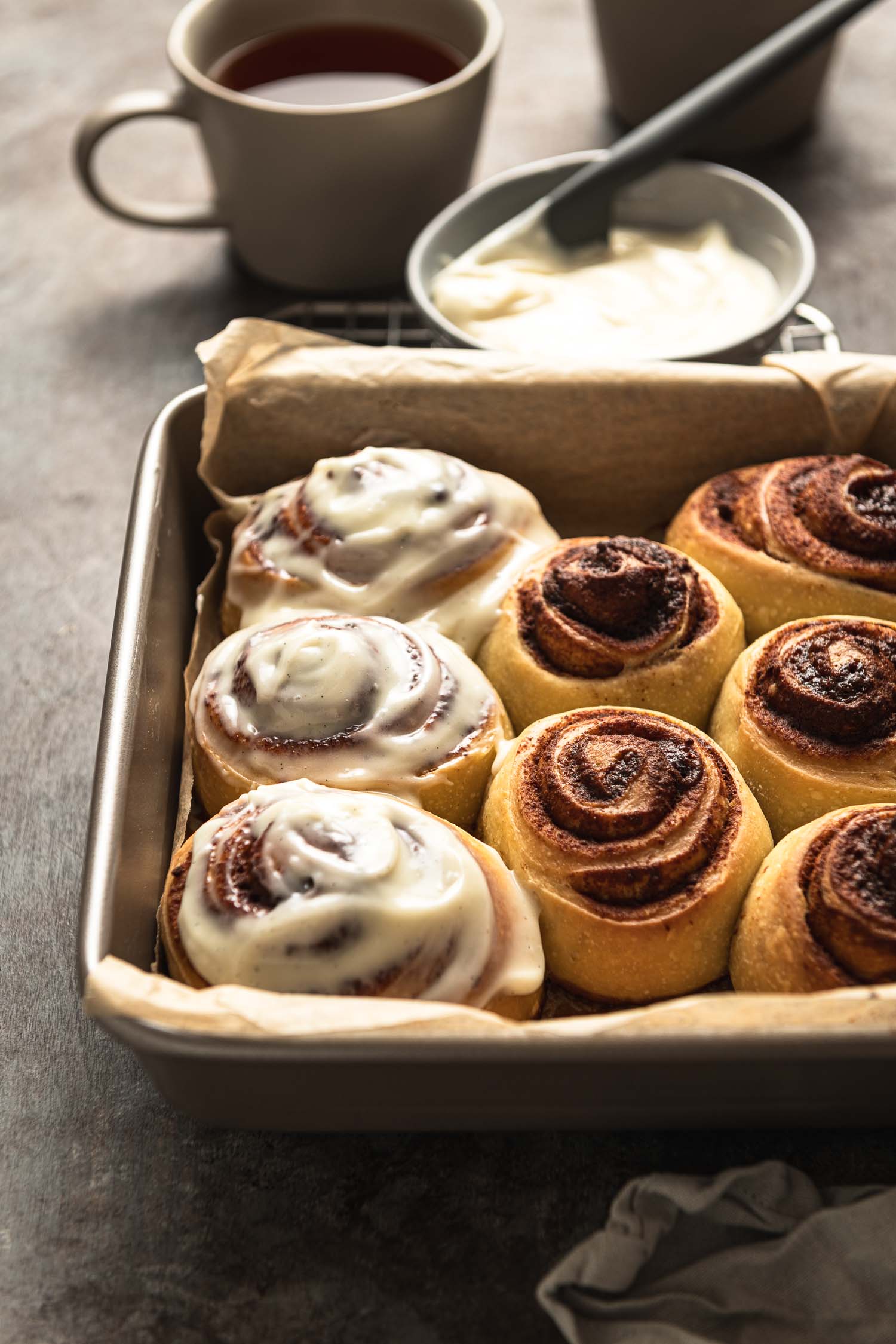
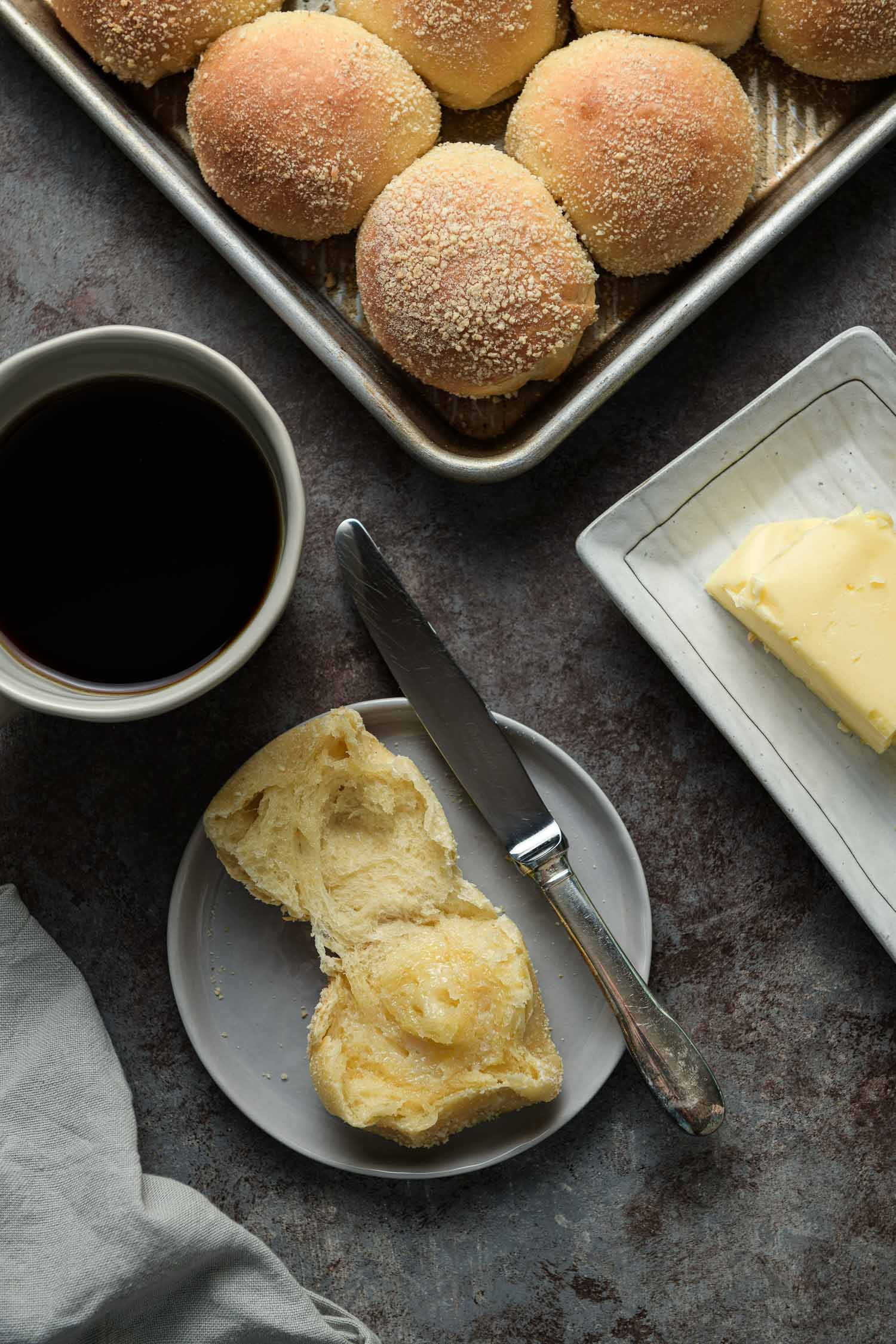
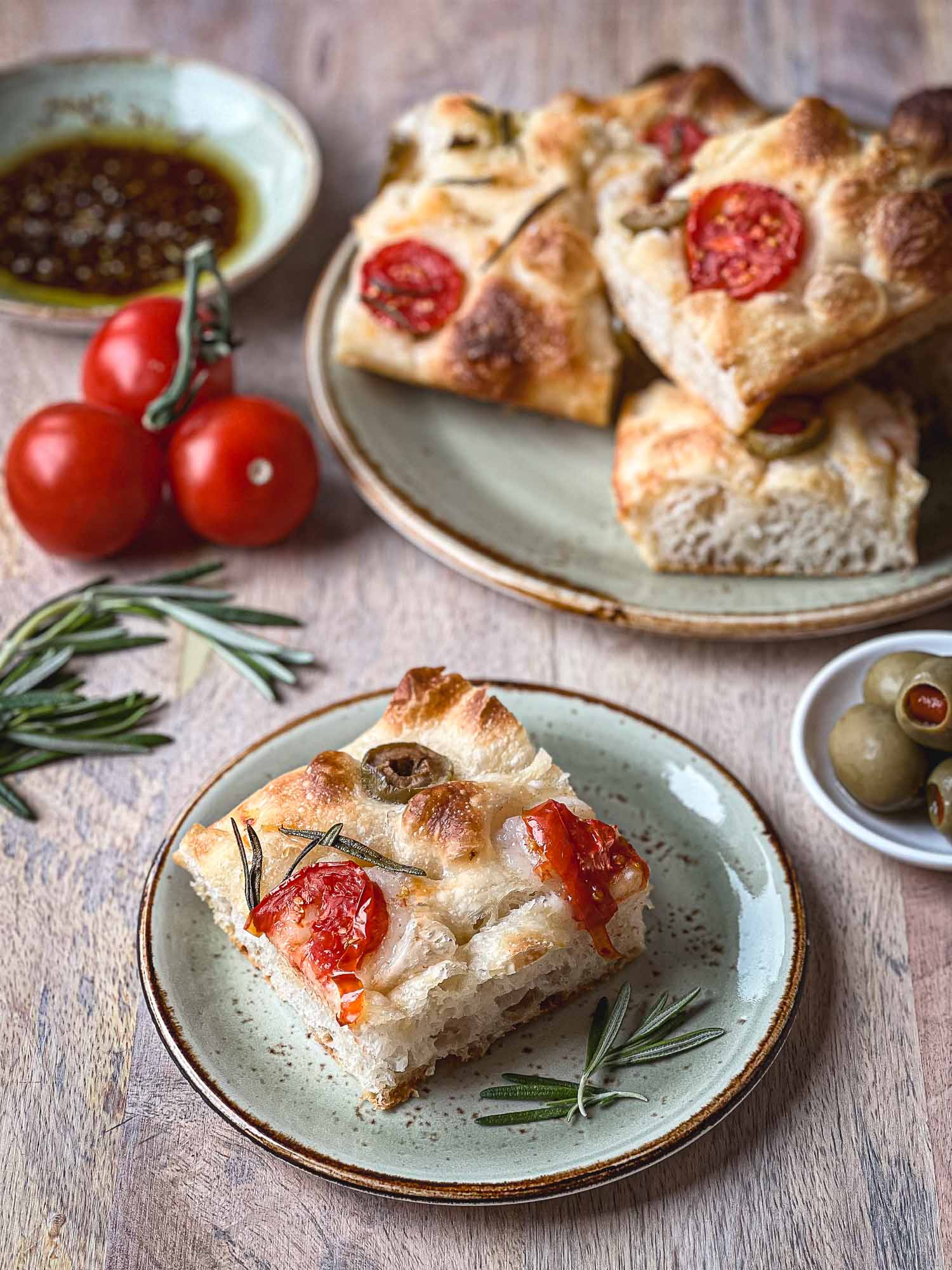

You are honestly a sourdough expert. Your love and passion, not to mention the dedication to detail makes me think book! You should do a sourdough book. GREG
There are so many great sourdough books out there already but I have secretly dreamed of putting out my own. Thanks for your vote of confidence–means a lot!! 🙂
Hello! Do you think these could be made with a whole grain flour?
Hi, Shannon. Yes, whole grain flour should work. One of my other English muffin recipes uses spelt flour. It might just be denser than one made with white flour. Here’s a link to that recipe for reference. https://lemonsandanchovies.com/2015/01/sourdough-spelt-english-muffins/
Just made these, and they’re really phenomenally good.
My sourdough starter isn’t quite where it needs to be (which I suspected; lovely sour taste but not much lift), so after it barely rose at all overnight, I proofed a small amount of yeast in a little warm water + pinch sugar, kneaded it into the dough (and added a little flour to balance the water I’d just added), and let it rise again for an hour or so, which salvaged the project. (IIRC I used 1 tsp active dry yeast, for anyone else thinking of making this with a still-developing starter.)
So glad you liked this recipe, Sarah, and thanks for the tip for bakers using a young starter. Thanks!!
I just made a double batch of these and just did the overnight ferment last night without refrigeration. I used honey for the sweetener and these are amazing! Thanks for sharing this recipe.
So happy to hear this, Kim. Thanks so much for taking the time to give me your feedback. Happy baking!
Hello, I was wondering if you knead the dough or perform and folds at the beginning of the bulk fermentation or after. Additionally should we push some of the air out of the dough before placing in the fridge over night ( after the initial bulk rise)? Thanks!
Hi, Shannon. For this recipe all you need to do is mix the ingredients and let it bulk ferment overnight. Then in the morning you transfer the dough onto a floured surface and just fold it over itself to create a ball and this serves to de-gas it before shaping into rounds before the final proof. I found a video that shows what I mean about folding the dough after bulk ferment–you can start watching at 1:45. Hope this helps. 🙂 https://www.youtube.com/watch?v=awX1rUCc8Oo
Do you have measurements in grams please?
Hello, I have updated the recipe to add the measurements in grams. The butter and honey/maple syrup are still in tablespoons but there’s a lot of leeway here so it should work. Hope this helps–I thought my English muffin recipes were already stated in grams so I had to remeasure. Thanks!
My dough is very wet after the initial mix. Is this normal?
Hi, Rebecca. My apologies for the late reply. I wanted to mix another batch of dough to verify my measurements and see the texture and everything checks out. The dough is higher hydration (about 90%) so it’s on the wet side (particularly if you use the higher amount of sourdough in the recipe). The dough should mix together easily but it will be sticky. Since there’s not much handling required until the dough is shaped after bulk fermentation and you’re free to use liberal amounts of flour at this stage hopefully it worked out for you. Happy to help if you have other questions. 🙂
LOVE this recipe, thank you. I found the dough surprisingly wet as well, Rebecca- thanks for asking the question. I used the 1/2 cup measurement for starter and it was more like a sponge than a sticky dough, rose beautifully overnight and in the morning, looked like an active starter with raisins! I used almost half a cup of flour to make a workable soft ball- they came out the best E. muffins we’ve made. Great tip to bake them after the skillet.
These are spectacular. Thanks for the recipe!
I used 100 gr of white whole wheat, and 157 gr of white bread flour, 168 gr of fed starter. I didn’t get a super rise overnight or in the final proof, so I was rather skeptical. But, once on the grill they popped right up. I did grilled them on 325F flat iron for 8 minutes per side, rotating 90 degrees after 4 minutes on each side, and skipped finishing in the oven
So glad you like this recipe, Miqqi. Thanks for giving it a chance and appreciate your feedback. 🙂
These look wonderful.. What would happen if an egg was added to the dough recipe? I have a recipe that uses an egg and it’s really tasty..Thanks for sharing.
Hi, Diana. I haven’t ever tried English muffins with egg but I bet they make the finished product lighter and softer. If you do end up incorporating eggs in this recipe I’d love to know how it turns out. 🙂
I’m going to try this recipe soon as my husband loves cinnamon raisin English muffins, but I’m curious if these can be frozen and then taken out later so that if he likes them I can make up a big batch for him to pull from later?
Hi, Tiffany. Yes, English muffins freeze well. I’ve done it a lot. 🙂